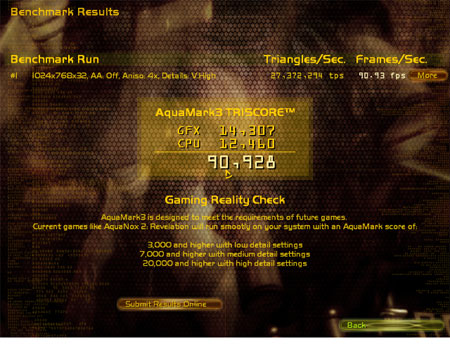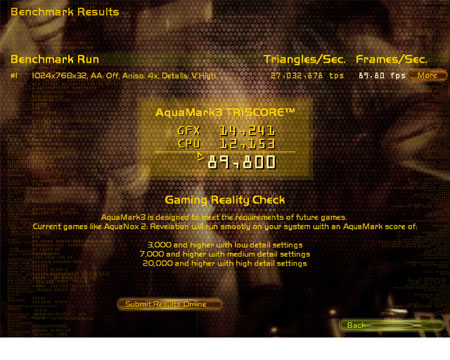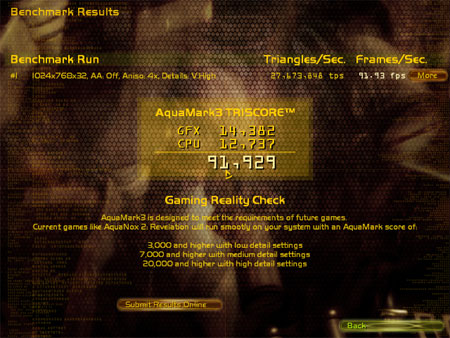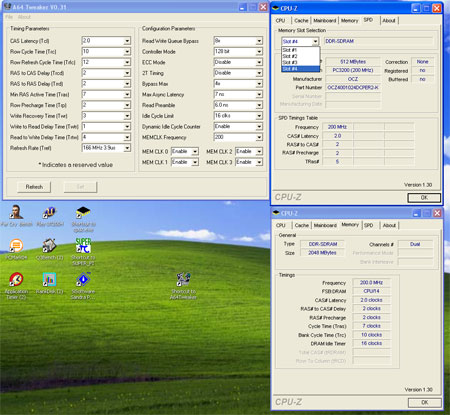DFI LANParty UT RDX200: ATI’s Crossfire AMD for the Bleeding Edge
by Wesley Fink on October 18, 2005 11:03 AM EST- Posted in
- Motherboards
4 DS DIMMs at 1T: Memory Stress Testing
The DFI easily handles 2-2-2-7-1T timings at stock speed with 2 double-sided dimms, as do almost any of the current boards for AMD Socket 939 from NVIDIA, SiS, VIA, and ULi. However, what is truly unique is that the DFI LANParty UT RDX200 is the first board designed to run four double-sided 512MB or 1GB DIMMs at the fastest timings and a 1T Command Rate. In fact, AMD specifications tell us that this is impossible. To his credit, Oskar Wu and DFI found a way to accomplish the impossible.
*7T was determined by MemTest86 benchmarks to deliver the widest bandwidth with the ATI Rx480/482 chipset. While the board would operate at tRAS of 5T or lower, all benchmarks were run at 7T.
With the ability to run 4 DS DIMMs at 1T, we had the opportunity to finally show the impact of a drop to a 2T Command Rate on performance.
First, for those skeptical that this is possible, we captured screens from the freeware A64 Tweaker and CPU-Z showing operation of 4 DIMMs at 1T.
All the benchmarks below were run with an FX-57 processor and are not directly comparable to our standard benchmarks which use an AMD 4000+ CPU.
To clearly demonstrate the impact of the normal 2T drop in Command Rate on performance, we ran Aquamark3 benchmarks with 2 DIMMs at 1T, 4 DIMMs at 2T, and the new option of 4 DIMMs at 1T.
For those who are thinking that surely there's a catch, the answer is "yes, there is". 1T operation is only possible to a frequency of about DDR406, which basically limits it to stock speeds. Above that speed, you must run 4 DS DIMMs at 2T as you normally must. However, at or near stock speeds, the 1T option is a brilliant development that delivers better performance.
The DFI easily handles 2-2-2-7-1T timings at stock speed with 2 double-sided dimms, as do almost any of the current boards for AMD Socket 939 from NVIDIA, SiS, VIA, and ULi. However, what is truly unique is that the DFI LANParty UT RDX200 is the first board designed to run four double-sided 512MB or 1GB DIMMs at the fastest timings and a 1T Command Rate. In fact, AMD specifications tell us that this is impossible. To his credit, Oskar Wu and DFI found a way to accomplish the impossible.
| Stable DDR400 Timings - 4 DIMMs (4/4 DIMMs populated) |
|
| Clock Speed: | 200MHz |
| CAS Latency: | 2.0 |
| RAS to CAS Delay: | 2T |
| RAS Precharge: | 7T* |
| Precharge Delay: | 2T |
| Command Rate: | 1T |
With the ability to run 4 DS DIMMs at 1T, we had the opportunity to finally show the impact of a drop to a 2T Command Rate on performance.
First, for those skeptical that this is possible, we captured screens from the freeware A64 Tweaker and CPU-Z showing operation of 4 DIMMs at 1T.
All the benchmarks below were run with an FX-57 processor and are not directly comparable to our standard benchmarks which use an AMD 4000+ CPU.
To clearly demonstrate the impact of the normal 2T drop in Command Rate on performance, we ran Aquamark3 benchmarks with 2 DIMMs at 1T, 4 DIMMs at 2T, and the new option of 4 DIMMs at 1T.



For those who are thinking that surely there's a catch, the answer is "yes, there is". 1T operation is only possible to a frequency of about DDR406, which basically limits it to stock speeds. Above that speed, you must run 4 DS DIMMs at 2T as you normally must. However, at or near stock speeds, the 1T option is a brilliant development that delivers better performance.











48 Comments
View All Comments
ozzimark - Tuesday, October 18, 2005 - link
it's very very very dependant on the cpu. notice that they used the FX-57 for those tests, which is a cpu that typically has some of the best memory controllers around.Wesley, how do 4xDS sticks perform with the 4000+?
Wesley Fink - Tuesday, October 18, 2005 - link
THe 4DSx1T worked fine on the 4000+. The key to this feature is the DRAM Drive Strength option in the BIOS. With older A64 drive strength needs to be set at 14 to 15. You can get things to work with a bit less DRAM Drive Strength with the newer controllers like those on the FX57.We mainly used the FX57 in the iT tests becuase it's fast, and the high stock test numbers made it easier to see the impact of the iT Command Rate on the various memory configurations.
ozzimark - Tuesday, October 18, 2005 - link
awesome, thanks Wesley. that's definitly a good thing to knowmongoosesRawesome - Tuesday, October 18, 2005 - link
depends on how high your memory will clock, and at what timings.LoneWolf15 - Tuesday, October 18, 2005 - link
I'm trying to make sure I understand this quote, Wesley...at the end, were you trying to say that you get little additional performance with the 7800GTX when compared to the 7800GT?
dornick - Tuesday, October 18, 2005 - link
He means you're wasting your money to buy a 7800gtx and play games at those settings when there are plenty of cheaper cards out there that do the job just as well.j@cko - Tuesday, October 18, 2005 - link
can i use nVidia SLI on ATi mobo?Wesley Fink - Tuesday, October 18, 2005 - link
Not yet. I have seen nVidia SLI running on the ATI Crossfire board but it required hacked video drivers. You will not see this option, or the reverse, until nVidia and ATI sanction this in their drivers.